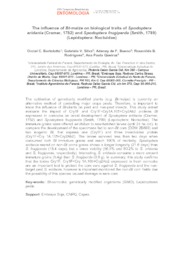The influence of Bt-maize on biological traits of Spodoptera eridania (Cramer, 1782) and Spodoptera frugiperda (Smith, 1789) (Lepidoptera: Noctuidae).
The influence of Bt-maize on biological traits of Spodoptera eridania (Cramer, 1782) and Spodoptera frugiperda (Smith, 1789) (Lepidoptera: Noctuidae).
Author(s): BORTOLOTTO, O. C.; SILVA, G. V.; BUENO, A. de F.; RODRIGUES, R. B.; QUEIROZ, A. P.
Summary: The cultivation of genetically modified plants (e.g. Bt-maize) is currently an alternative method of controlling major crops pests. Therefore, is important to know the influence of Bt-plants on pest and non-pest insects. This study aimed evaluate the impact of Cry1F and Cry1F+Cry1A.105+Cry2Ab2 proteins Bt expressed in corncobs on larval development of Spodoptera eridania (Cramer, 1782) and Spodoptera frugiperda (Smith, 1789) (Lepidoptera: Noctuidae). The immature grains were offered ad libitum to new-hatched larvae (until 24 hs old), to compare the development of the specimens fed to non-Bt corn (DOW 2B688) and two isogenic Bt, that express one (Cry1F) and three insecticides protein (Cry1F+Cry 1A.105+Cry2Ab2). The larvae survived less than two days when consumed both Bt immature grains and reach 100% of mortality. Spodoptera eridania reared on non-Bt corns grains shows a longer longevity (21.6 days) than S. frugiperda (18.4 days), but a lower viability (56.5% and 80.2% to S. eridania and S. frugiperda, respectively). Interesting, S. eridania consume a more amount immature grains (5.4g) than S. frugiperda (3.9 g). In summary, this study confirms that the toxins Cry1F, Cry1F+Cry 1A.105+Cry2Ab2 expressed in fresh corncobs are an important tool to protect the corn ears against S. frugiperda and the nontarget pest S. eridania, however is important monitored the non-Bt corn fields due the possibility of this species caused damage in ears corn.
Publication year: 2014
Types of publication: Abstract in annals or event proceedings
Unit: Embrapa Soybean
Keywords: Corn, Corn cobs, Espiga, Genetically modified organisms, Milho, Organismo transgênico
Observation
Some of Embrapa's publications are published as ePub files. To read them, use or download one of the following free software options to your computer or mobile device. Android: Google Play Books; IOS: iBooks; Windows and Linux: Calibre.
Access other publications
Access the Agricultural Research Database (BDPA) to consult Embrapa's full library collection and records.
Visit Embrapa Bookstore to purchase books and other publications sold by Embrapa.

